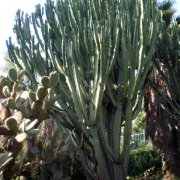Care of the succulent plant Euphorbia candelabrum or Candelabra tree |
|
The genus Euphorbia, family Euphorbiaceae, includes 2,000 species of succulents, trees, shrubs, and herbaceous plants of cosmopolitan distribution. Some species are: Euphorbia candelabrum, Euphorbia viguieri, Euphorbia meloformis, Euphorbia bubalina, Euphorbia lomelii, Euphorbia canariensis, Euphorbia pulcherrima, Euphorbia resinifera, Euphorbia milii, Euphorbia tithymaloides, Euphorbia regis-jubae, Euphorbia royleana, Euphorbia trigona, Euphorbia bivonae, Euphorbia characias, Euphorbia echinus, Euphorbia cotinifolia, Euphorbia rigida, Euphorbia handiensis, Euphorbia balsamifera, Euphorbia coerulescens, Euphorbia leucocephala. Common names: Candelabra tree, Sudanese tree-euphorbia, Sudan tree-euphorbia, Candelabra cactus. This species is native to the Horn of Africa. They are succulent plants (cactiforms) of great size that reach 10 meters (32.8 feet)in height. They have an inverted triangle bearing; the trunk branches to create a triangular crown. The columnar branches are divided into 4 angles like the Cereus cacti. They produce small greenish-yellow flowers on the edges. Candelabra tree is used as isolated specimens, in rockery and in cactus and succulent gardens. The young specimens are used in pots on patios and terraces, as indoor or greenhouse plants. They are fairly slow growing plants. Euphorbia candelabrum needs full sun exposure; indoors it needs a well-lit and well-ventilated location. The soil can be a mixture of 2/3 peat and 1/3 sand or a commercial cactus substrate with 25% coarse sand. Water moderately in spring and summer waiting until the substrate has dried. Go reducing irrigation in autumn until almost eliminating it in winter. Candelabra cactus is a plant resistant to pests and diseases but sensitive to excess watering. Euphorbia candelabrum propagates by seeds or by cuttings in spring. |
Images of the succulent plant Euphorbia candelabrum or Candelabra tree |
Find plants
Euphorbia candelabrum or Candelabra tree | Care and Growing
© 2026 FavThemes




